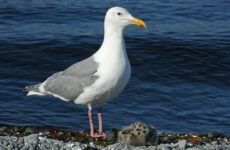

Royal Terns are large, but sleek and graceful waterbirds whose black crests on breeding adults make them stand out against the background of sandy beaches.
Their bright red-orange, dagger-like bills are also noticeable against the stark white of their bodies and the gray color of their wings. They have white, forked tails, black legs, and black, webbed feet.
Non-breeding adult Royal Terns lose part of their black crest, leaving them with a white forehead and a shaggy black band at the back of their heads. Their wings, while still gray, have darker or close to black wingtips.
Juveniles are like non-breeding adults with a shaggy, black partial cap, but their bills are yellow-orange like their legs and feet, and their wings have a gray and black mottling pattern. Some of them have black wingtips.
- Thalasseus maximus
- Length: 18 – 21 in (46 – 53 cm)
- Weight: 16 oz (453 g)
- Wingspan: 42 – 44 in (107 – 112 cm)
Range
Royal Terns are resident all year along the coast of the eastern United States, Central and South America, and the Caribbean.
Habitat And Diet
You can find Royal Terns in saltwater habitats, like beaches, bays, and offshore areas. When foraging, they can fly toward open water. They are usually grouped on undisturbed beaches because they’re very social birds.
Royal Terns typically feed on small fish, shrimp, and other aquatic animals. They may forage on their own, in small or large groups, and sometimes with other bird species. They typically “plunge-dive” to get at their prey, except when they’re preying on small crabs like young blue crabs.
Royal Tern Calls:
Nests
Nests of Royal Terns are located on isolated, undisturbed sandy beaches or rocky islands with very few predators. The nests are just shallow depressions on the ground, sometimes unlined, but the breeding pair defecates on the nest rim to strengthen them. The female then lays one or two eggs that are incubated from twenty-five to thirty days.
Once the eggs hatch, the chicks remain in the nest for about a week and then they gather with the other chicks of the colony and they form a “creche”. Their own parents can recognize them and feed them despite being together with other chicks.
Fun Fact:
Colonies of Royal Terns, like any Tern species, have a group behavior called “dread” or “panic” in response to a predatory threat. They all fly off their nests, hover silently over their colony, from a minute to as much as several hours, and then slowly resettle.









